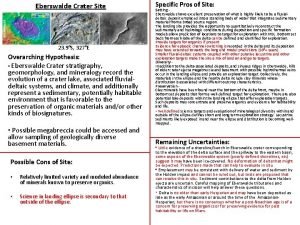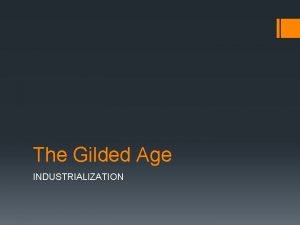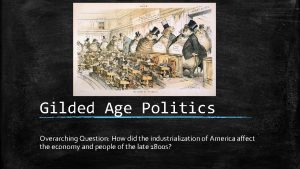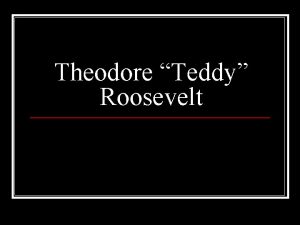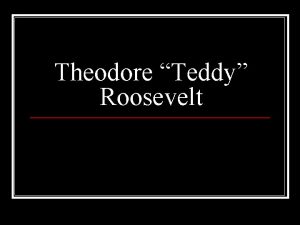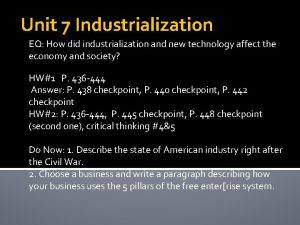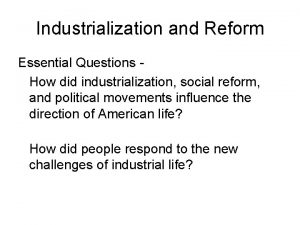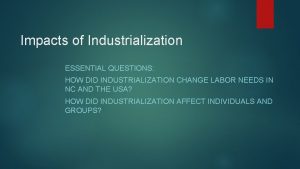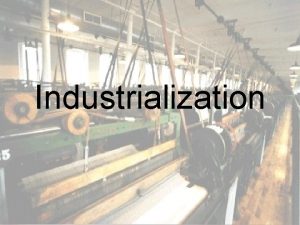American Industrialization Overarching Question How did the industrialization












- Slides: 12

American Industrialization Overarching Question: How did the industrialization of America affect the economy and people of the late 1800 s?

The Gilded Age lasted from 1870 -1900 The name came from the title of a Mark Twain book "Gilded" means covered with gold on the outside, but not really golden on the inside The Gilded Age was a period of rapid economic growth but also much social conflict and political corruption

Historical Context ▪ Post Civil War/Reconstruction ▪ The Settlement of the West ▪ Darwinism- Social Darwinism ▪ Political Corruption (will cover more in-depth later on) ▪ Continued immigration- shifting from Irish/German/Chinese to more Southern and Eastern European (Italian, Polish, Slavic, Slovakian) - important to note first two groups still emigrating in large numbers with exception of the Chinese because of the Exclusion Act. Synthesis: 2 nd wave of the Industrial Revolution compared and contrasted to the first war in early-mid 1800 s market/industrial revolution.

I. The Machine Age (1865 -1900) A. Primary characteristics of American Industrialization 1. Production by machine rather than by hand 2. Involvement of an increasing proportion of the work force in manufacturing 3. Production concentrated in large, intricately organized factories 4. Accelerated technological innovation, emphasizing new inventions and applied science 5. Expanded markets, no longer local and regional in scope

I. The Machine Age (1865 -1900) continued 6. Growth of a nationwide transportation network based on the railroad, along with a communications network based on the telegraph and telephone 7. Increased capital accumulation for investment in expansion of production 8. Growth of large enterprises and specialization in all forms of economic activity 9. Steady increase in the size and predominance of cities (will go more in-depth on cities in the future)

I. The Machine Age (1865 -1900) continued B. Iron and steel--central to development of American industry 1. Andrew Carnegie--Scottish immigrant who built the steel industry with a mill that integrated all stages of refinement process (from ore to finished rails) 2. Railroad growth fueled industrial development. Over 100, 000 miles of track were laid between 1877 and 1893, doubling the U. S. network a) Standardization of gauge (width of tracks set at 4 feet, 8 1/2 inches) encouraged development b) Time zone adoption allowed co-ordination of systems (U. S. divided into four zones) c) Adoption of steel rails, bearing heavier loads d) Massive grants of American land (131 million acres from federal government, 49 million acres from states)

I. The Machine Age (1865 -1900) continued C. Oil & John D. Rockefeller 1. First oil derrick drilled in Titusville, Pennsylvania in 1859 2. Rockefeller organized Standard Oil Co. and bought out smaller refiners 3. Organized trusts to combine companies, reduce competition, and increase profits

II. Organization of American Labor A. Legalized by Commonwealth v. Hunt in 1842, labor unions tended to be small and limited to skilled trades B. Labor strife arose in the 1870 s with frequent strikes 1. Haymarket Massacre, Chicago, 1886 occurred when a bomb killed 7 and wounded 70 2. Homestead Strike in Pennsylvania, 1892 resulted in seven deaths -Pinker tons, Carnegie & Frick 3. Pullman Strike, 1894 in Chicago temporarily stopped railroad traffic and required federal intervention

II. Organization of American Labor Continued C. Labor organizations 1. Knights of Labor (1869). Sought to create one big union of all workers, skilled and unskilled. Opposed to strikes 2. American Federation of Labor (1886). Organized by Samuel Gompers. Focused on higher wages, shorter hours, and safer working conditions 3. Eugene Debs and American Railway Union (1892). Socialist approach that viewed government and owners as enemies of workers

III. Utopian Economic Plans A. Henry George Progress and Poverty(1879)--inequality's source: rising land values. Single land tax proposed to end monopolies and bring social progress B. Edward Bellamy Looking Backward(1888)--extremes of wealth and poverty need to be countered with socialist state free of vicious competition C. Henry Lloyd Wealth Against Commonwealth(1894)--aggression of trusts, particularly Rockefeller's, would lead to economic slavery. Cooperation with the government owning and operating the means of production would produce equality

IV. New Issues for Labor A. As machines and new procedures (including assembly line) reduced demand for labor, employers cut costs further by hiring large numbers of women and children 1. By 1900, 20% of all manufacturing workers were women (up from 11% in 1870). 2. By 1900, 13% of all textile workers were younger than 16. B. Working conditions resulted in 25, 000 deaths in industrial accidents per year 1. Triangle Shirtwaist Fire (NYC) in 1913 resulted in 146 deaths 2. 72, 000 railroad workers killed between 1900 and 1917 C. Court cases 1. In Lochner v. New York (1905), Supreme Court ruled that 60 -hour work week limit was unconstitutional 2. In Muller v. Oregon (1908), Court reversed Lochner and limited women's working hours to 10 per day.

John Green if time https: //www. youtube. com/watch? v=r 6 t. Rpz. RUJs&index=24&list=PL 8 d. Puua. Lj. Xt. Mwmep. Bj. TSG 593 e. G 7 Obz. O 7 s
 Costa levels of questions
Costa levels of questions The lives of others music by
The lives of others music by Data driven messaging
Data driven messaging Overarching design
Overarching design Single overarching communication outcome
Single overarching communication outcome Overarching hypothesis
Overarching hypothesis Overarching narrative
Overarching narrative Overarching hr strategies
Overarching hr strategies Overarching strategies
Overarching strategies Overarching strategies
Overarching strategies Present simple question words
Present simple question words Nudging probe questions
Nudging probe questions Contoh paraphrase
Contoh paraphrase





